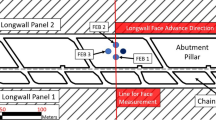Abstract
We propose a simple pressure test that can be used in the field to determine the effective permeability of existing wellbores. Such tests are motivated by the need to understand and quantify leakage risks associated with geological storage of CO2 in mature sedimentary basins. If CO2 is injected into a deep geological formation, and the resulting CO2 plume encounters a wellbore, leakage may occur through various pathways in the “disturbed zone” surrounding the well casing. The effective permeability of this composite zone, on the outside of the well casing, is an important parameter for models of leakage. However, the data that exist on this key parameter do not exist in the open literature, and therefore specific field tests need to be done in order to reduce the uncertainty inherent in the leakage estimates. The test designed and analyzed herein is designed to measure effective wellbore permeability within a low-permeability caprock, bounded above and below by permeable reservoirs, by pressurizing the reservoir below and measuring the response in the reservoir above. Alternatively, a modified test can be performed within the caprock without directly contacting the reservoirs above and below. We use numerical simulation to relate pressure response to effective well permeability and then evaluate the range of detection of the effective permeability based on instrument measurement error and limits on fracture pressure. These results can guide field experiments associated with site characterization and leakage analysis.





Similar content being viewed by others
References
Anfort SJ, Bachu S, Bentley LR (2001) Regional-scale hydrogeology of the Upper Devonian–Lower Cretaceous sedimentary succession, south-central Alberta Basin, Canada. Am Assoc Petrol Geol 85:637–660
Avci CB (1994) Evaluation of flow leakage through abandoned wells and boreholes. Water Resour Res 30:2565–2578
Bachu S (2000) Sequestration of CO2 in geological media: criteria and approach for site selection in response to climate change. Energy Convers Manage 41:953–970
Bachu S (2002) Sequestration of CO2 in geological media in response to climate change: road map for site selection using the transform of the geological space into the CO2 phase space. Energy Convers Manage 43:87–102
Bachu S, Haug K, Michael K, Buschkuehle BE, Adams JJ (2005) Deep injection of acid-gas in western Canada. In: Tsang CF, Apps JA (eds) Underground injection science and technology. Elsevier, Amsterdam, pp 623–635
Bear J (1972) Dynamics of fluids in porous media. Elsevier, Amsterdam
Bruant RG, Guswa AJ, Celia MA, Peters CA (2002) Safe storage of CO2 in deep saline aquifers. Environ Sci Technol 36:240A–245A
Celia MA, Bachu S, Nordbotten JM, Kavetski D, Gasda SE (2006) A risk assessment tool to quantify CO2 leakage potential through wells in mature sedimentary basins. Paper presented at the 8th international conference on greenhouse gas control technologies, Trondheim, 19–22 June, 2006
Chesnaux R, Chapuis RP, Molson JW (2006) A new method to characterize hydraulic short-circuits in defective borehole seals. Ground Water 44:676–681
Gasda SE, Bachu S, Celia MA (2004) Spatial characterization of the location of potentially leaky wells penetrating a deep saline aquifer in a mature sedimentary basin. Environ Geol 46:707–720
Holloway S (2001) Storage of fossil fuels-derived carbon dioxide beneath the surface of the earth. Annu Rev Energy Environ 26:145–166
Javandel I, Tsang CF, Witherspoon PA, Morganwalp D (1988) Hydrologic detection of abandoned wells near proposed injection wells for hazardous-waste disposal. Water Resour Res 24:261–270
Nelson EB (1990) Well cementing (developments in petroleum science). Elsevier, Amsterdam
Nordbotten JM, Celia MA, Bachu S, Dahle HK (2005) Semianalytical solution for CO2 leakage through an abandoned well. Environ Sci Technol 39:602–611
Schlumberger Ltd (2007) UNIGAGE Quartz Specifications. http://www.slb.com/content/services/testing/data/unigage_quartz_gauge_specs.asp. Cited 11 March 2007
Acknowledgments
This work was sponsored in part by a grant from BP and Ford Motor Company through funding of the Carbon Mitigation Initiative at Princeton, and by the National Science Foundation through a graduate fellowship to S. E. Gasda. We also thank Stefan Bachu of the Alberta Geological Survey for his important contributions to this work.
Author information
Authors and Affiliations
Corresponding author
Rights and permissions
About this article
Cite this article
Gasda, S.E., Nordbotten, J.M. & Celia, M.A. Determining effective wellbore permeability from a field pressure test: a numerical analysis of detection limits. Environ Geol 54, 1207–1215 (2008). https://doi.org/10.1007/s00254-007-0903-7
Received:
Accepted:
Published:
Issue Date:
DOI: https://doi.org/10.1007/s00254-007-0903-7




